Creole Seafood Jambalaya with succulent shrimp, tender chicken, and spicy andouille sausage is an easy, make-ahead, flavorful, one-pot recipe.
Found all along the Gulf Coast but especially in New Orleans and Southern Louisiana, this seafood jambalaya also includes perfectly seasoned long grain rice, iconic “holy trinity vegetables,” luscious tomatoes, and the bold punch of Creole seasoning.
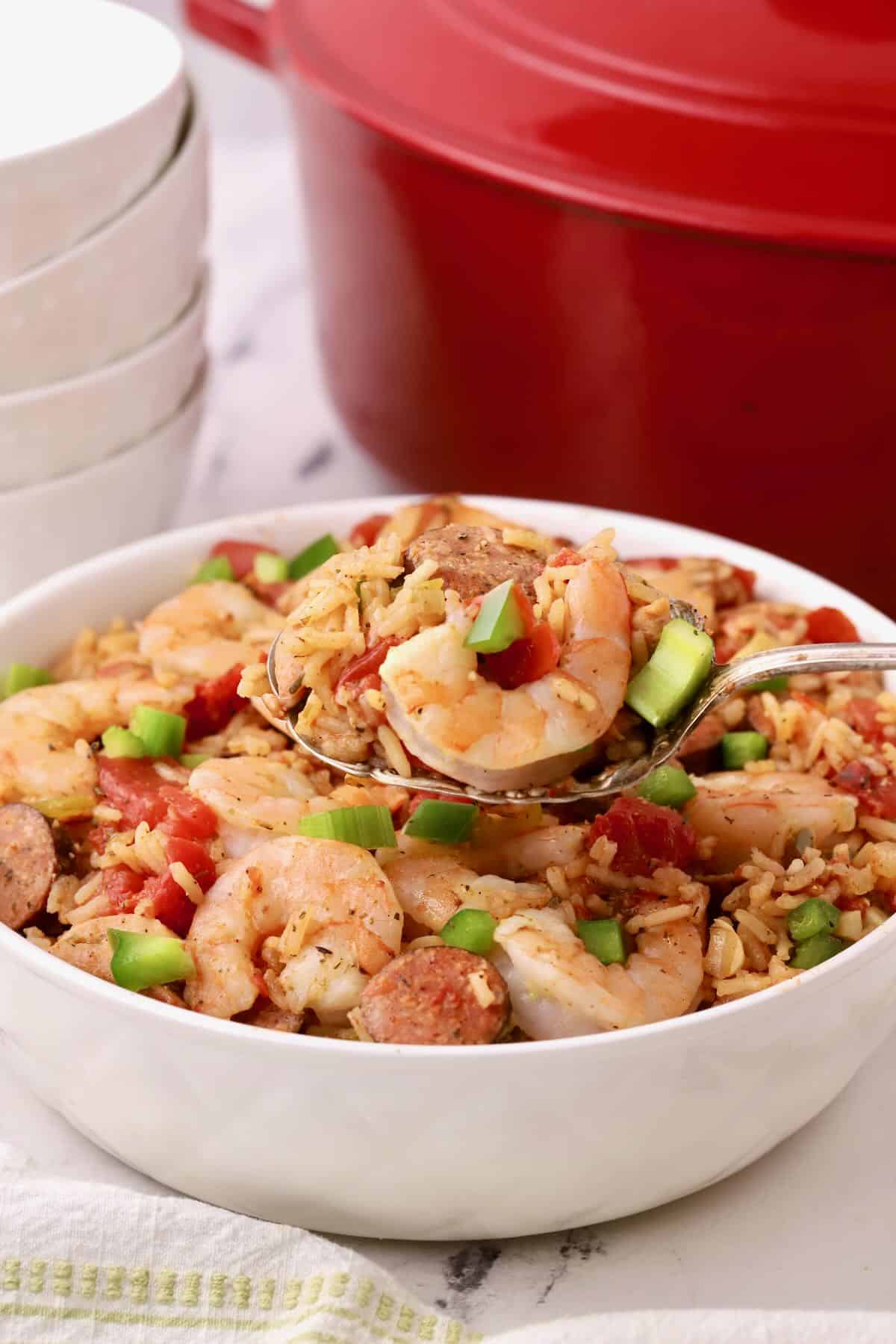
Like my recipes for Cajun Shrimp and Grits and Dirty Rice with Sausage, homemade seafood jambalaya with Creole flavors is a feast for the senses! It’s a meal in one, and it’s guaranteed to tantalize your taste buds. But, best of all, it’s an easy jambalaya recipe.
Not only is it a mandatory dish on everyone’s Mardi Gras menu, it’s also perfect for a quick weeknight meal with your family, and it’s a great dish to feed a crowd!
Jump to:
- Why this is the best recipe:
- The origin of jambalaya:
- Ingredient notes and substitutions:
- How to make seafood jambalaya:
- The difference between Creole and Cajun jambalaya:
- Make it ahead:
- Recipe variations:
- Side dishes that pair well with this recipe:
- Leftovers, storage, and reheating:
- Recipe FAQs:
- Expert tips:
- More easy Creole recipes and Cajun recipes:
- 📋 Recipe:
Why this is the best recipe:
- Unlike many jambalaya recipes, this version pays homage to the rich culinary traditions of the Gulf Coast.
- This delicious seafood recipe provides foolproof step-by-step instructions for preparing the perfect Creole seafood jambalaya and expert tips to ensure your dish turns out perfectly every time.
- It guarantees an unforgettable dining experience that will keep your family and friends returning for more. Because it’s a one pot jambalaya, you only have one pot to wash.
The origin of jambalaya:
The origin of jambalaya is rooted in the cultural melting pot of Louisiana, particularly in the region around New Orleans and the broader Gulf Coast. The dish’s history is closely tied to Spanish paella, a rice-based dish that includes rice, meats, vegetables, and spices.
Jambalaya was born out of necessity and creativity. Folks adapted their recipes based on the available ingredients. As a result, jambalaya became a flexible dish that could incorporate a variety of meats, including chicken, sausage, seafood, and even wild game such as deer, wild boar, duck, and alligator.
Ingredient notes and substitutions:
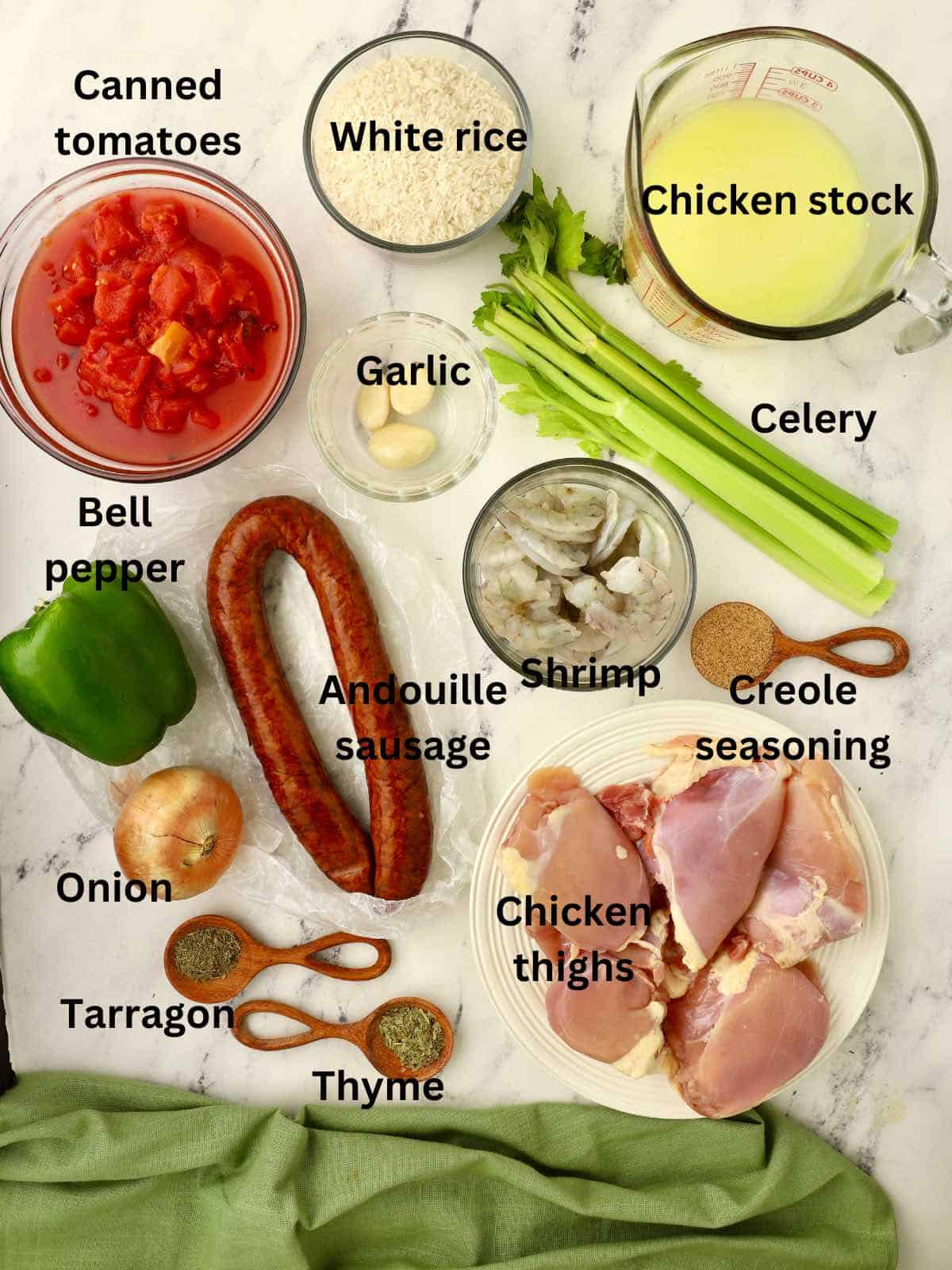
- Shrimp – is the star of this Creole seafood extravaganza. Added at the end, shrimp pairs well with the chicken and sausage, making this a hearty dish satisfying even the biggest appetites. While fresh is best, thawed frozen shrimp work too!
- Boneless, skinless chicken thighs – are better suited to this recipe’s longer cooking process as they can maintain moisture and tenderness over time, unlike chicken breasts, which can quickly become overcooked and dry.
- Andouille sausage – is smoked and heavily seasoned with spices, particularly garlic, pepper, and paprika. This recipe calls for one pound andouille sausage. When cooked, andouille sausage releases its flavorful juices, infusing the entire dish with a smoky, spicy, and robust taste. This flavor is a hallmark of authentic jambalaya.
- Onion, green bell pepper, and celery – are known as the “holy trinity” in Creole and Cajun cooking. This mix of vegetables is a fundamental component in creating the rich and distinctive flavors of dishes like gumbo, jambalaya, and étouffée. Red bell pepper can be substituted for the green pepper.
- Garlic – contributes a savory and slightly pungent taste that forms the base of the dish. This depth of flavor is essential for creating the well-rounded flavor jambalaya is known for.
- Creole seasoning – is a flavorful spice blend that is a staple in Creole cooking. It typically includes paprika, garlic powder, onion powder, cayenne pepper, oregano, and thyme. It adds depth, heat, and a distinct Creole flair to these dishes. You can substitute homemade Cajun seasoning, which is used in Cajun cuisine, however, you might want to use a bit less because it adds more heat.
- Thyme and tarragon – are dried herbs that add even more flavor and complexity to the dish.
- Long grain white rice – acts as a canvas for absorbing the rich and robust flavors of the other ingredients, including meats, vegetables, and seasonings. It also contributes to the dish’s texture, structure, and appeal. You can substitute different types of rice, including long-grain brown rice, basmati rice, or converted rice, but you must adjust the cooking time and liquid.
- Chicken stock – acts as the liquid that binds the various elements of jambalaya together, infusing the dish with a depth of flavor, moisture, and a rich foundation. You can substitute chicken broth or three cups seafood stock.
- Tomatoes – the use of tomatoes in traditional and play a significant role in Creole or red jambalaya, contributing flavor, color, and a tangy element to the dish. I like using “fire-roasted” to add a rich, smoky flavor. Regular diced tomatoes or crushed tomatoes can be substituted.
- Olive oil – is used to keep the chicken and sausage from sticking. (Not pictured)
Complete measurements are in the printable recipe card below.
How to make seafood jambalaya:
- Gather your ingredients and heat the olive oil in a large Dutch oven over medium-high heat.
- When the pan is hot, add the chicken and sausage and cook until browned on all sides, which will take about ten minutes. Be sure to stir frequently to prevent the meat from sticking.
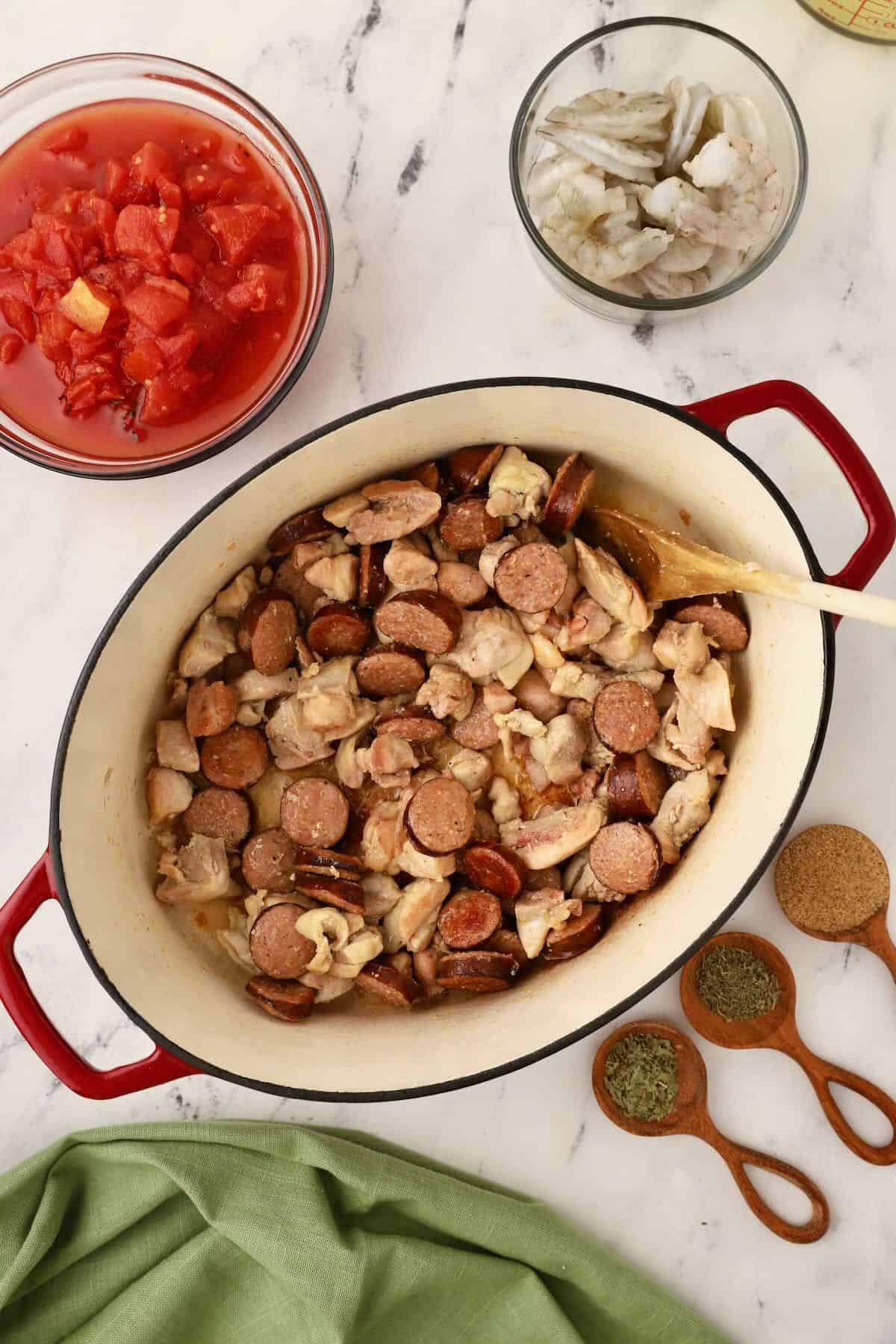
- When the chicken and sausage are done, remove them from the pan with a slotted spoon and place them in a bowl. Cover loosely to keep warm and set aside.
- Add the onion, bell pepper, and celery to the pan drippings and cook for about five minutes.
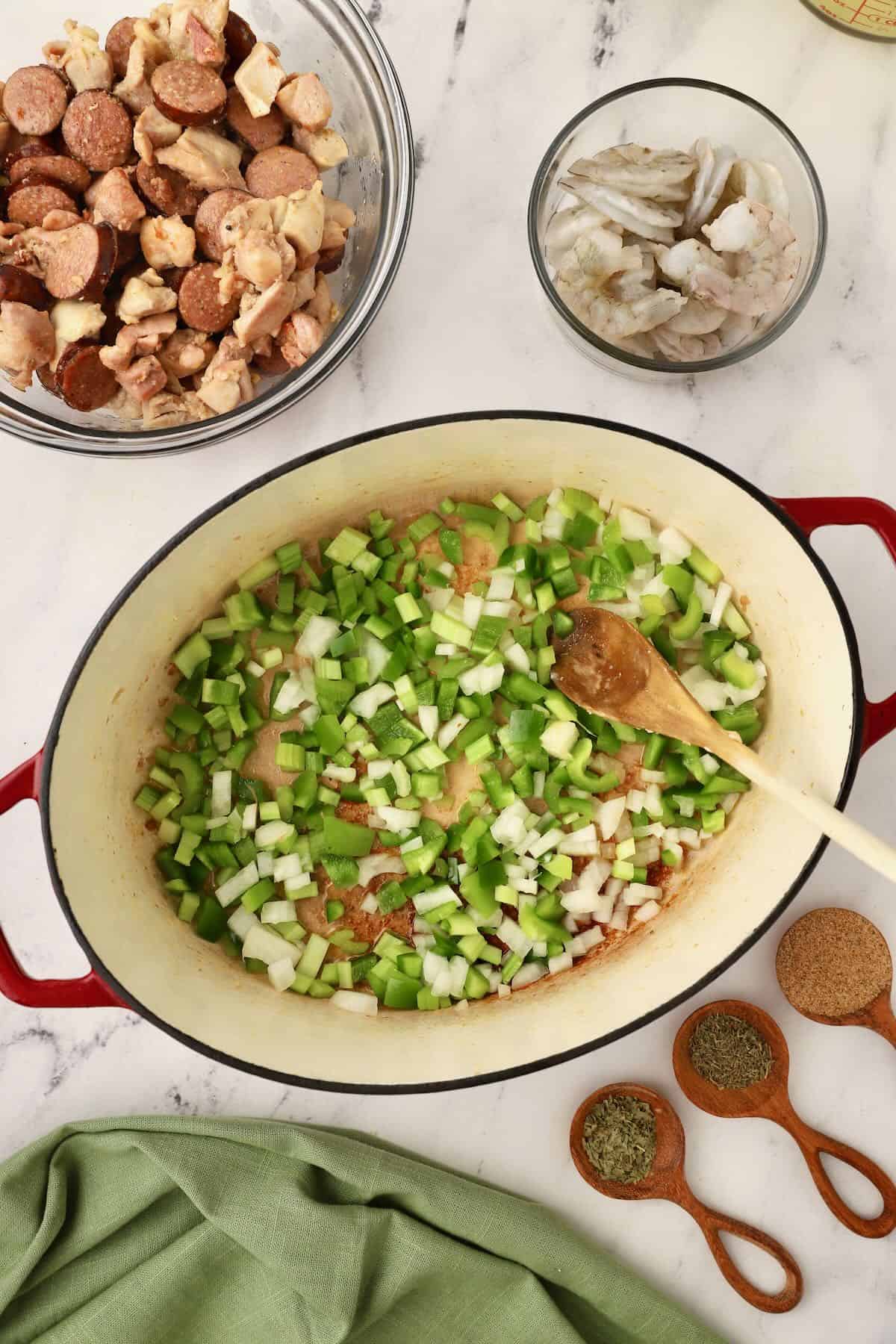
- Add the Creole seasoning, thyme, and tarragon and continue cooking for another five minutes. Add the garlic and cook for 30 seconds. Stir frequently.
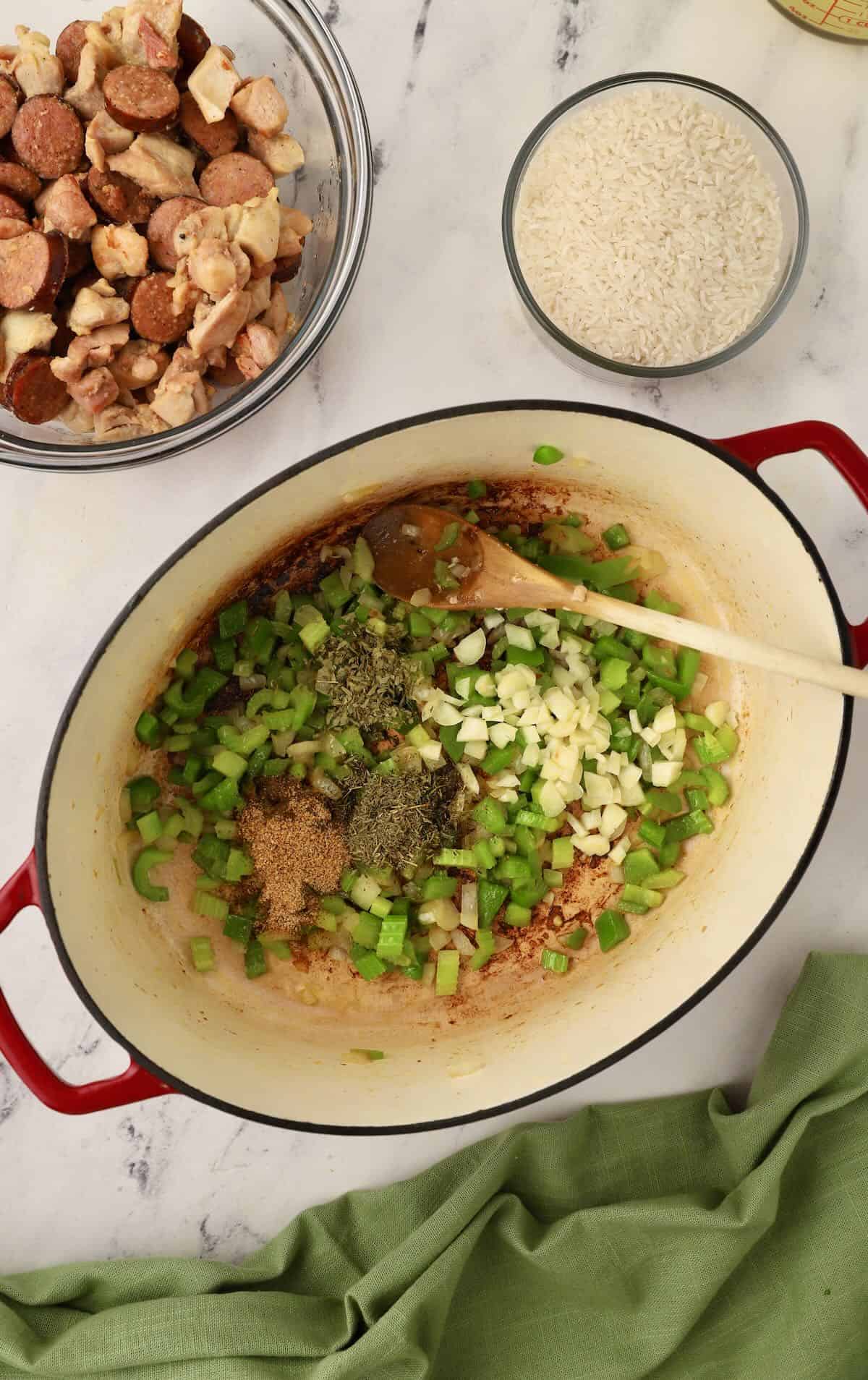
- Add the uncooked rice and stir until well combined — Cook for three minutes.
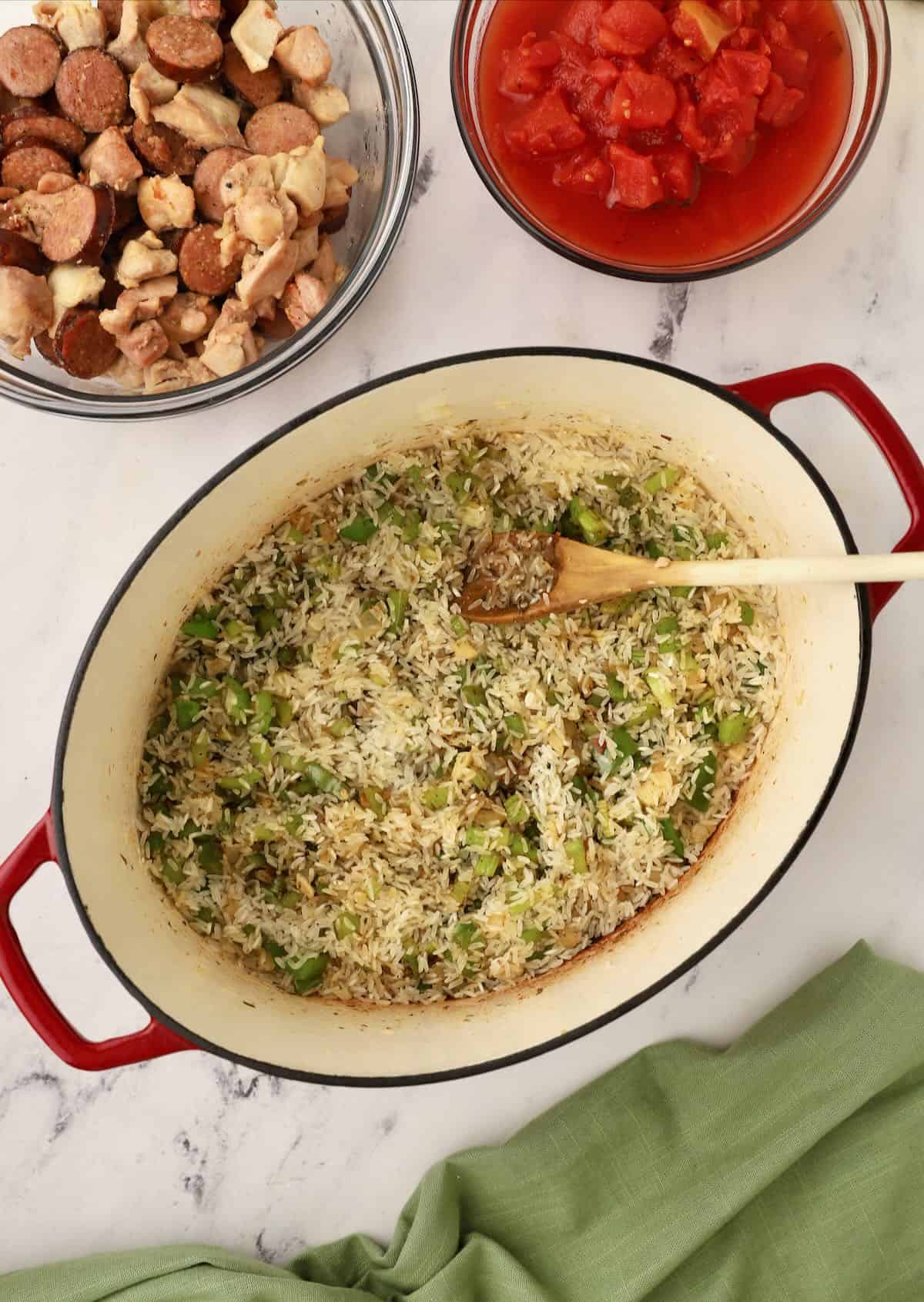
- Add the chicken and sausage back to the pan, and then add the chicken stock and tomatoes. Stir well to combine and bring to a boil.
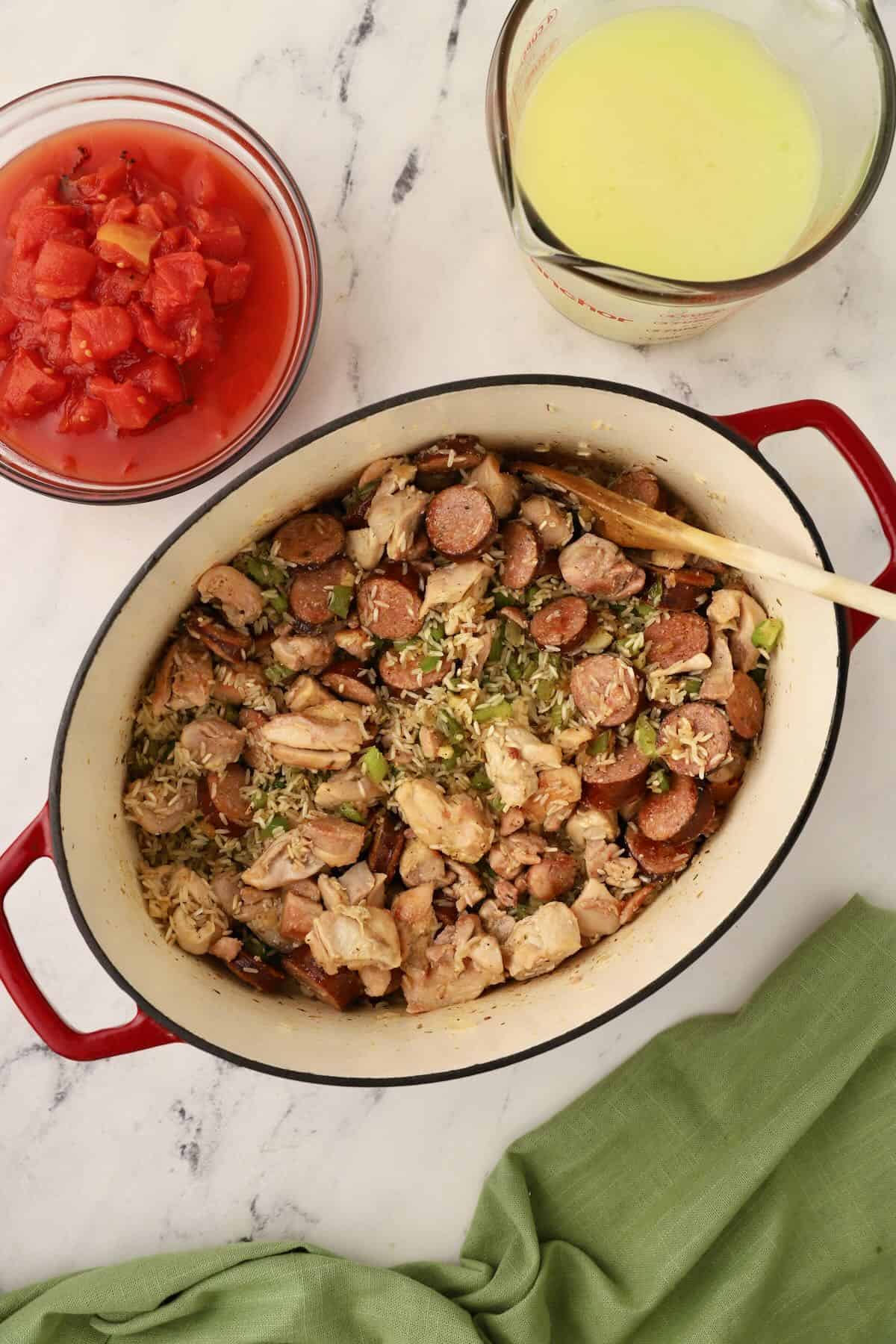
- Stir again, cover, and reduce the heat to medium-low. Cook covered for about 20 minutes, stirring occasionally.
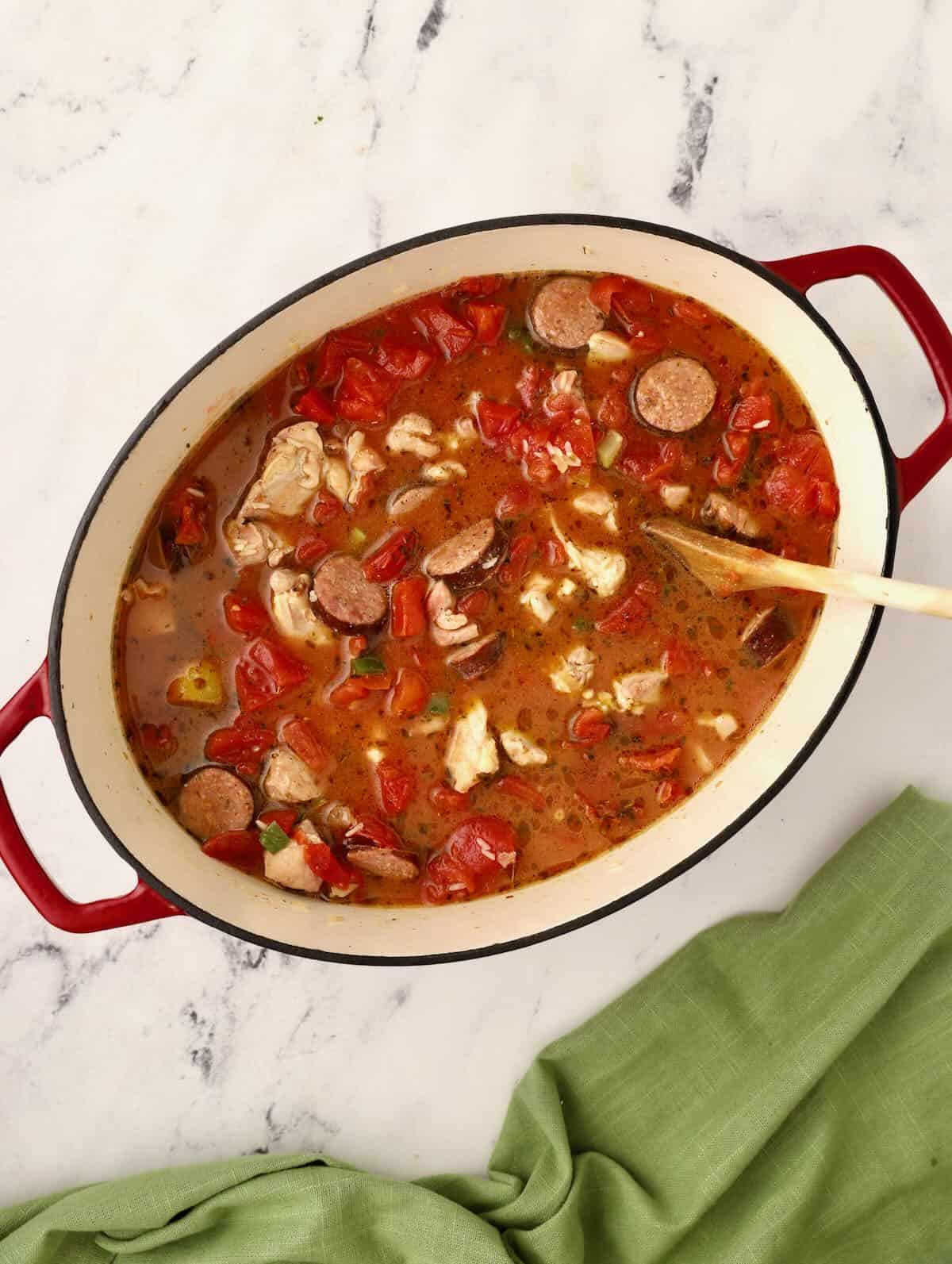
- Remove the pan from the stove, add the shrimp, stir them in, and let it sit covered for ten minutes to allow them to cook.
- Serve immediately.
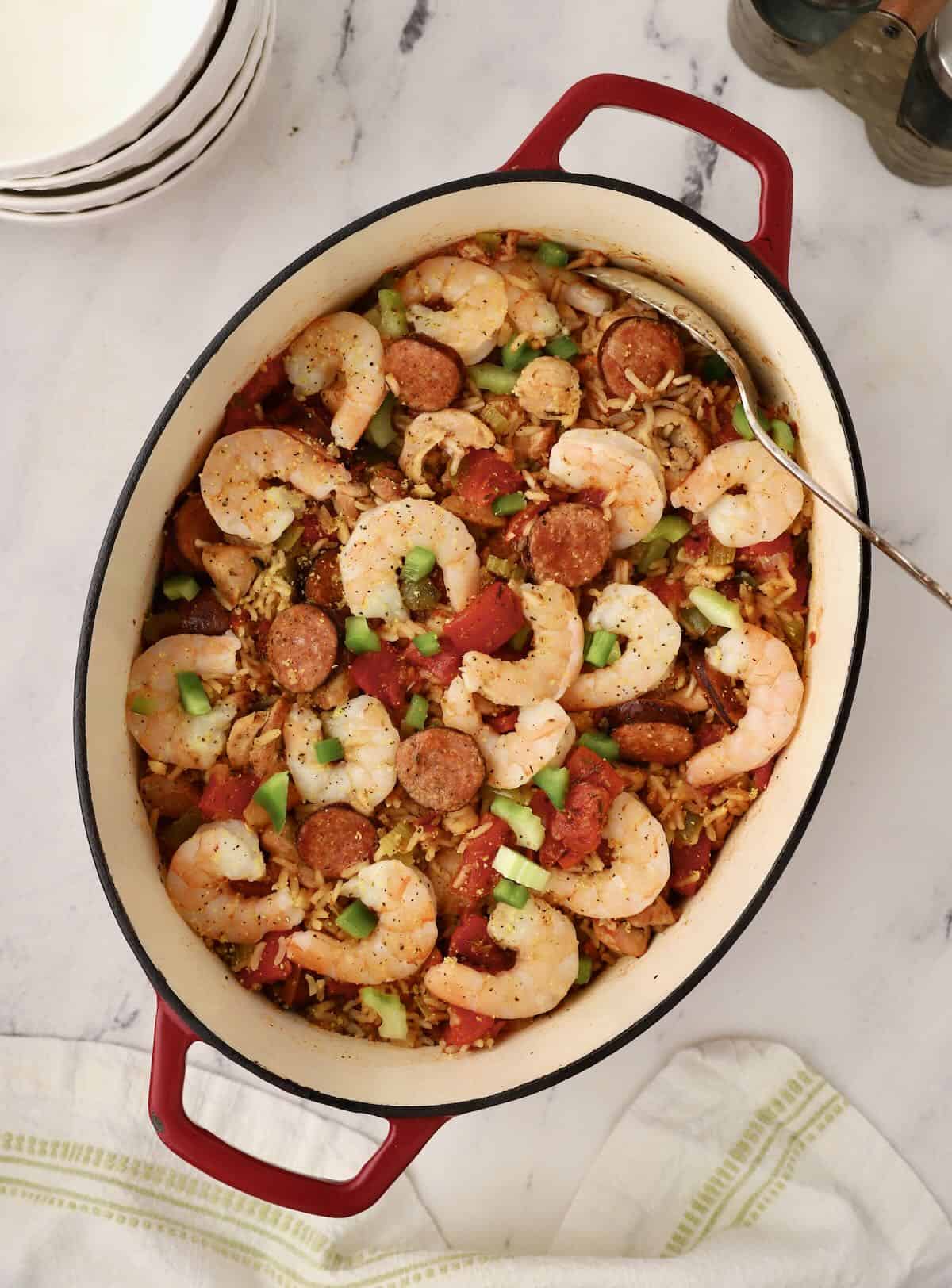
The difference between Creole and Cajun jambalaya:
My seafood jambalaya recipe is considered a Creole jambalaya, or “red jambalaya,” because it includes tomatoes.
Cajun jambalaya, or “brown jambalaya,” on the other hand, starts with a roux; it is made without tomatoes and has a more rustic feel. and taste
Make it ahead:
This recipe can be made ahead of time, and like many pasta recipes, tastes even better the second day after the flavors have had a chance to come together.
To make it ahead, make the recipe as directed, except don’t add the shrimp. Allow it to cool, and then store it in an airtight container in the fridge for up to 24 hours. It can be frozen for longer storage.
When you are ready to serve it, add it to the Dutch oven, and gently reheat it over medium heat on the stove until the jambalaya is warmed through. Then add the shrimp and cook for another ten minutes, until the shrimp are done.
Before reheating, you will have to add a few splashes of chicken stock or water, as the rice tends to absorb the liquid.
If frozen, let the dish thaw overnight in the fridge, and then let it sit out for about 30 minutes before following the reheating directions and adding the shrimp.
Recipe variations:
- Instead of adding chicken and andouille sausage, make a classic seafood-only jambalaya by adding crab meat, clams, mussels, scallops, crawfish, lobster, or fish to the shrimp.
- Make a shrimp and andouille sausage jambalaya by leaving out the chicken.
- Substitute different types of sausage including kielbasa, Polish sausage, chorizo, and Italian sausage for the andouille. The taste won’t be quite the same, but they all work in this recipe.
- Make a chicken and sausage jambalaya by leaving out the shrimp.
- Add a splash of dry white wine such as Chardonnay or dry Sherry to the dish before serving for added flavor.
- Add additional flavor by adding a tablespoon of tomato paste, chopped-up green onions, or a bay leaf to the rice when it is cooking. Also
Side dishes that pair well with this recipe:
This is a hearty and flavorful main course that can be served as a meal. However, here are some tasty options that would make it a true Mardi Gras dinner:
Appetizer: Hot Muffuletta Dip or Mardi Gras Snack Mix. Add a Hurricane Cocktail to introduce a Mardi Gras theme and set the tone for a festive evening.
Bread: Southern Cornbread, Hoe Cakes, Hush Puppies, or Texas Toast Garlic Bread would all be delicious.
Vegetables: Collard Greens, Fried Okra, or Grilled Vegetables would be nice accompaniments.
Salad: Spinach Salad with Apples and Pecans, Cucumber and Tomato Salad, Broccoli Slaw with Ramen Noodles, or Brussels Sprout Salad would be lovely.
Dessert: Serving Pralines and Cream Ice Cream, Old-Fashioned Pecan Pralines, Southern Pecan Praline Cake, or Southern Pecan Praline Cheesecake would make your family or guests think they were in the French Quarter and be a sweet ending to a fabulous meal.
Leftovers, storage, and reheating:
Allow the leftovers to cool down slightly after cooking, and transfer to an airtight container. If you have a large batch, you can divide it into smaller portions for easier storage.
Place the container in the refrigerator if you plan to consume the leftovers within three to four days. For longer storage, you can freeze them.
To reheat refrigerated leftovers, add them to a pot or skillet over medium heat. You will probably need to add a splash of chicken broth or water to prevent them from drying out. Stir occasionally to ensure even heating and to prevent sticking to the bottom of the pot.
If you freeze the leftovers, it’s best to thaw them in the refrigerator overnight before reheating. Once thawed, follow the same reheating instructions as for refrigerated leftovers.
Recipe FAQs:
Mardi (French for Tuesday) Gras (French for Fat) refers to Shrove or Fat Tuesday. Mardi Gras is a major cultural event, lasting for weeks until the actual day of celebration, Fat Tuesday, the day before Ash Wednesday, or the beginning of Lent.
It is celebrated worldwide, and in the US, New Orleans is the most famous, but it is also celebrated in other cities along the Gulf Coast including Mobile and Pensacola.
Yes, you can use frozen seafood but it must be thawed before adding it to the jambalaya.
Yes, I would say it is a six or seven on a scale of one to ten. You can adjust the heat level by reducing the amount of Creole seasoning you use, or if you like a lot of heat, add a dash of hot sauce, or a pinch or two of red pepper flakes.
Jambalaya is similar to gumbo and étouffée but doesn’t have filé or okra like gumbo. Unlike étouffée, it does include andouille or smoked sausage. The other main difference is that jambalaya is cooked with rice, and gumbo and étouffée are served over rice prepared separately.
The “holy trinity” is a mix of vegetables (onions, celery, and bell peppers) that forms the flavor base of many Cajun and Creole dishes, including jambalaya.
Expert tips:
- Chop, slice, and measure all your ingredients before you start cooking. This is known as “mise en place” and will make preparing this dish easier.
- Use long-grain white rice in this recipe, which absorbs flavors well while maintaining its structure. Follow the rice-to-liquid ratio recommended in the recipe to ensure perfectly cooked rice.
- Shrimp cooks quickly, so add it at the end of the cooking process to prevent overcooking. Once the shrimp is added, gently fold it into the jambalaya to avoid breaking it up.
- Allow the seafood jambalaya to rest for a few minutes before serving. This helps the flavors meld and allows any excess moisture to be absorbed.
More easy Creole recipes and Cajun recipes:
Need more menu ideas or recipes? Check out this collection: 25 Mardi Gras Recipes and Menu Ideas, or all of my Mardi Gras recipes.
⭐ ⭐ ⭐⭐⭐If you make this dish, please leave a comment and give this recipe a star rating. I would love to know how you liked it!
Thank you so much for visiting Grits and Pinecones; I hope you come back soon!
📋 Recipe:
Want to Save This Recipe?
Enter your email & I’ll send it to your inbox. Plus, get great new recipes from me every week!
By submitting this form, you consent to receive emails from Grits and Pinecones.
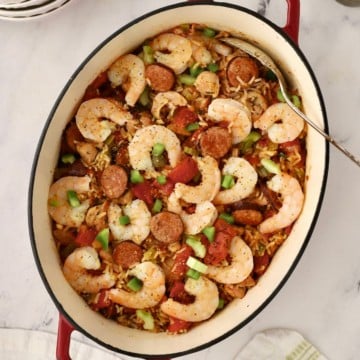
Creole Seafood Jambalaya Recipe (Shrimp and Sausage)
Ingredients
- 1 tablespoon olive oil
- 1½ pounds boneless skinless chicken thighs, (about 6) cut into one-inch pieces.
- 1 pound Andouille sausage, sliced
- 1 large white or Vidalia onion, chopped
- 1 large green bell pepper, chopped
- 3 stalks celery, chopped
- 3 cloves garlic, minced or grated
- 1 tablespoon Creole seasoning
- 1 teaspoon dried thyme
- 1 teaspoon dried tarragon
- 1½ cups uncooked long-grain white rice
- 3 cups chicken stock
- 29 ounces canned diced fire-roasted tomatoes undrained, 2-14.5 oz cans
- 1 pound extra-large, 21-25 per pound raw shrimp, peeled and deveined with the tails removed
Instructions
- Gather your ingredients and heat the olive oil in a large Dutch oven over medium-high heat.When the pan is hot, add the chicken and sausage and cook until browned on all sides, which will take about ten minutes. Be sure to stir frequently to prevent the meat from sticking.
- When the chicken and sausage are done, remove them from the pan with a slotted spoon and place them in a bowl. Cover loosely to keep warm and set aside.
- Add the onion, bell pepper, and celery to the pan drippings and cook for about five minutes.
- Add the Creole seasoning, thyme, and tarragon, and cook for another five minutes. Add the garlic and cook for 30 seconds. Stir frequently.
- Add the uncooked rice and stir until well combined — Cook for three minutes.
- Add the chicken and sausage back to the pan, and then add the chicken stock and tomatoes. Stir well to combine and bring to a boil.
- Stir again, cover, and reduce the heat to medium-low. Cook covered for about 20 minutes, stirring occasionally.
- Remove the pan from the stove, add the shrimp, stir them in, and let it sit covered for ten minutes to allow them to cook.
- Serve immediately with your favorite sides.


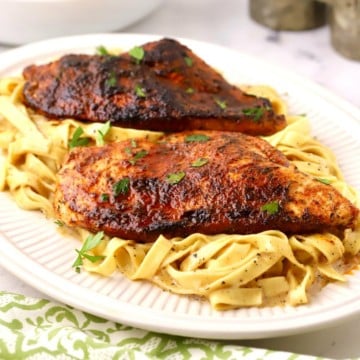
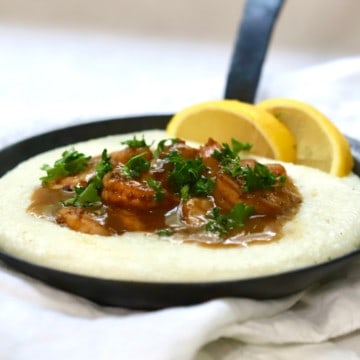
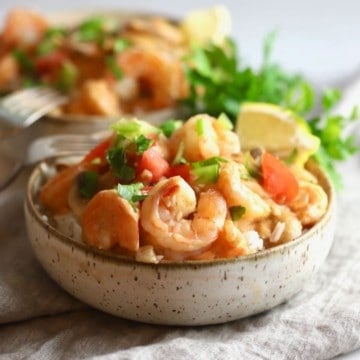
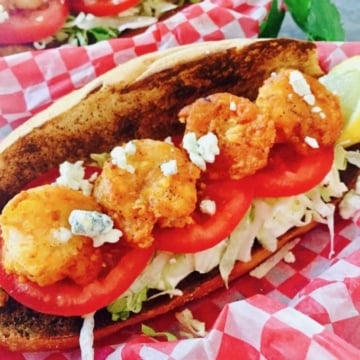
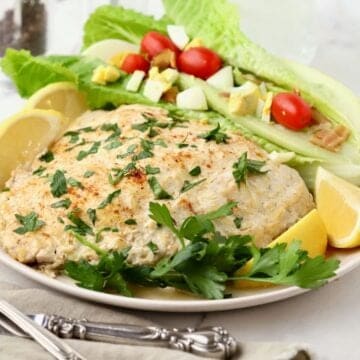

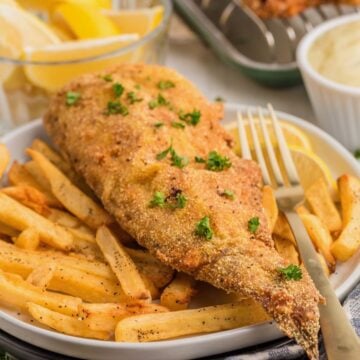
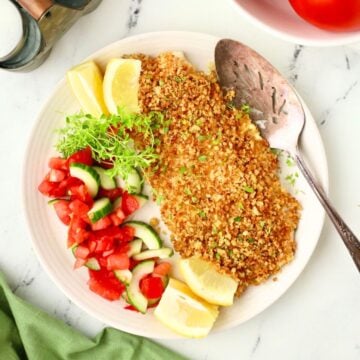

RaeAnn
I organize a Taste of New Orleans Community Benefit. I struggle with rice getting mushy. I am going to try cooking rice in the oven. Would I reduce just the chicken stock? I want to make food prep easy so can I make this in advance and just warm it up?
Sharon Rigsby
Hi RaeAnn, I have never made this any other way than the recipe I posted, which has you cooking the rice along with everything else. I have never cooked rice in the oven, so I can say if this would work or not, but I think you should be fine cooking it according to the recipe and then just reheating it. That said, if any of my other readers have any suggestions for Rae Ann, please pass them along here.
All the best,
Sharon
Francine
Delicious and easy to make.
Annette Monberger
I’d like to make this recipe at night and then put it in a crock pot for the next day at a work Mardi Gras Party. Any suggestions so that I don’t over cook any of the ingredients in the dish. Thank you.
Gritsandpinecones
Hi Annette, although I’ve never used a crockpot, this jambalaya is delicious the next day reheated so I think it would work just fine. I think if it was me, I would keep it refrigerated at work and then about an hour before you plan to serve it, put it in the crockpot to reheat. I would definitely spray the inside of the crockpot with non-stick cooking spray first, and you might also want to bring about a cup of chicken stock with you just in case to add if the jambalaya starts looking dry. I would only add about a tablespoon at a time because you don’t want it soupy. Hope this helps and good luck!
All my best,
Sharon